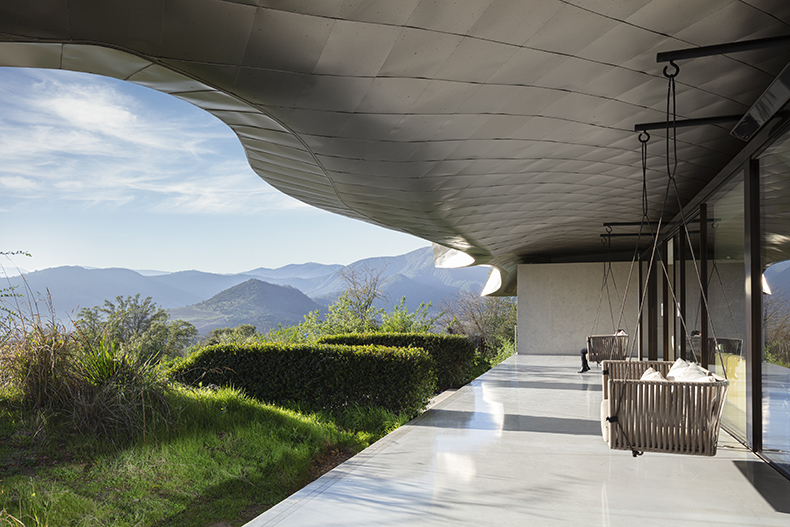From the May 2022 issue of Apollo. Preview and subscribe here.
Carrie and Alexander Vik founded their 4,450-hectare Chilean wine estate Viña Vik in 2004. The project is a tale of what happens when art and design enthusiasts turn their hand to winemaking, and of the pleasure such well-designed wine engineers. By incorporating art into the vineyard, Vik creates a holistic environment for indulging in the totality of aesthetic pleasure, blending wine, design and hospitality. ‘Great wine requires a madman to grow the vine, a wise man to take care of it, a lucid poet to produce it, and a lover to drink it,’ Salvador Dalí said. Wine intoxicates, but it also opens us up to a more intense, authentic experience of our nature. This encounter of art and design in a vineyard in the Chilean wilderness demonstrates Viña Vik’s commitment to the natural processes of winemaking and, as Carrie Vik says, ‘pushes the boundaries of what visitors think about design’.
New World wines often have to shake off some unfair prejudices – they are either bulk-produced value wine for supermarkets, or passion projects of small-scale producers that never cross borders. But Chile has been winemaking since the arrival of the Jesuits, and the wine critic Tim Atkin is adamant it has a promising future and that its wine can ‘compete with the best wines in the world’. It is this forward-looking attitude the winemakers adopted when they were searching for the location to create ‘the best wine in South America,’ according to Alexander Vik. Because of the environmental intensities of a country 4,270km long and only 177km wide, it took a long time to find the ideal spot for their vineyard. The Vik team sampled 86 locations to find the perfect soil, testing minerality, rainfall and air temperature, before settling in the Colchagua region, next to a wildlife reserve.
Vik’s chief winemaker, Cristián Vallejo, who has made wine for notable houses including Château Margaux, explains how an ‘awareness of all the vineyard elements and how they interact’ makes ‘the most elegant, dynamic and expressive wines’. He presides over 360 plots, blending five grapes: Cabernet Sauvignon, Cabernet Franc, Syrah, Merlot, and the once maligned Carménère, now the national grape of Chile. This region provided ‘the freedom to implement all the best practices of winemaking from the history and science of winemaking,’ Carrie says – toasting French oak barrels with felled oak from the estate’s forest, for instance. The wines have found success in premium markets; the globally renowned critic James Suckling awarded the 2018 vintage 98 points.
Courtesy Viña Vik

Estates now frequently commission architects to create spectacular buildings for their wineries, which become manifestos for the winemaking ethos of each house. For Viña Vik’s winery the Chilean-Croatian architect Smiljan Radic incorporated sustainable practices and technological innovation into the minimalist elegance of his design. Radic, whose work appeared at the Venice Biennale in 2018 and who created the Serpentine Pavilion in 2014, sought a vernacular design working in partnership with the land. The resulting structure is simultaneously daring yet unobtrusive, a sliver of material that does not lose itself in the surrounding landscape, because the vines provide balance.
Radic’s design integrates environmentally conscious elements in a terrain where viniculture makes difficult demands in terms of irrigation and energy use. Its stretched white fabric roof protects the barrels from sunlight while eliminating the need for artificial light. The working sections are underground, cooling the wine through the valley’s natural temperature. Pathways to the vineyard cross running water on metal sheets (also naturally cooling). The paths are punctuated by boulders of varying sizes that look like fallen meteorites. These are sculptures by the Chilean artist Marcela Correa, which echo the Andean moonscape feel.
Viña Vik is also a museum of modern art, but – because it is situated on a vineyard – a living museum. The way nature, the seasons, the time-of-day change around the artworks affects how they are experienced. Works include several Roberto Matta pieces, a James Turrell light box, and an Anselm Kiefer diptych from his series The Secret Life of Plants. The 22 suites of the hotel, too, are immersive artworks decorated by Chilean artists. The success of the rooms comes from the ‘artist really involving himself in the process and spending time in this space – and you feel it,’ Alexander says. One suite took the hyperrealist Alvaro Gabler six months to complete. ‘If you are a realist you must follow through every detail until the end. You cannot do half-hearted realism,’ Gabler insists. The result is pristine, white and grey with trompe l’oeil cornices and canvases from ceiling to floor. The room is so mathematically precise that guests will be reluctant to fully unpack, lest they sully the effect.
The best moment of drinking wine ‘confronts us with the mystery of our freedom’, as Roger Scruton wrote: it is the in-between and betwixt phase, when we are not sober but not yet inebriated. Vik captures this feeling through the placing of art and design within the natural landscape of the vines. ‘Some people say it’s arrogant, but we are trying to do something that hasn’t been done before,’ Alexander says. Vik competes with the best of the Old World, but through innovation and sustainable viniculture, turns its back on it, choosing instead to celebrate the freedom of the Chilean terroir and the know-how required to design extraordinary wine and experiences from this land.
From the May 2022 issue of Apollo. Preview and subscribe here.


